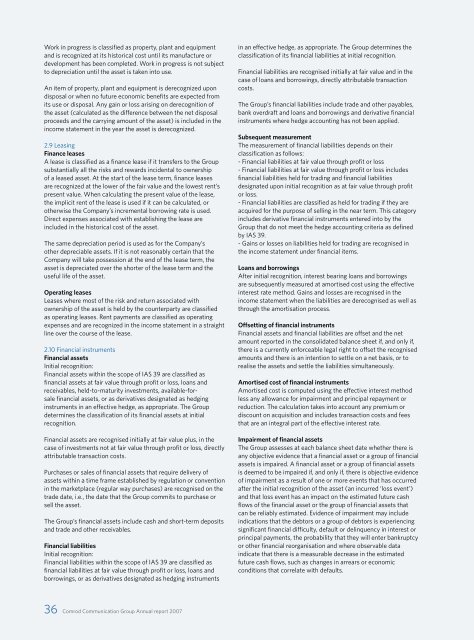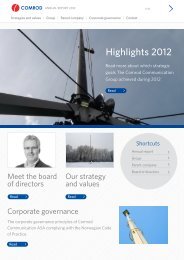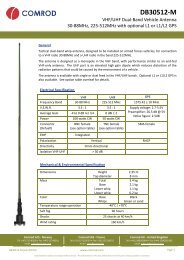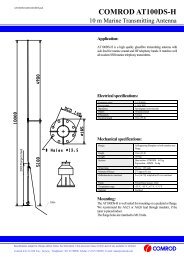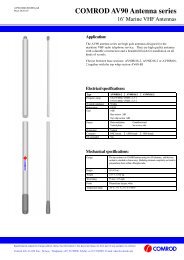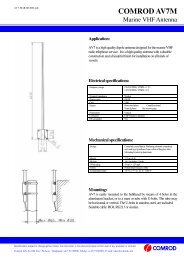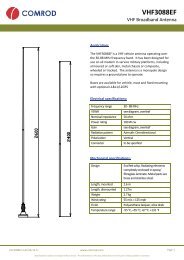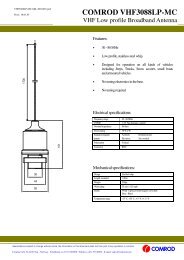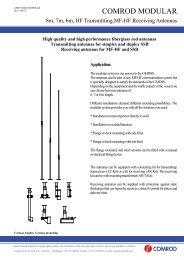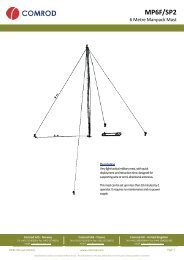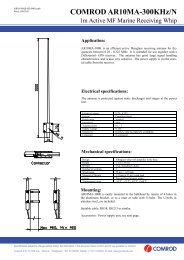Annual report 2008 - Comrod
Annual report 2008 - Comrod
Annual report 2008 - Comrod
- No tags were found...
You also want an ePaper? Increase the reach of your titles
YUMPU automatically turns print PDFs into web optimized ePapers that Google loves.
Work in progress is classified as property, plant and equipmentand is recognized at its historical cost until its manufacture ordevelopment has been completed. Work in progress is not subjectto depreciation until the asset is taken into use.An item of property, plant and equipment is derecognized upondisposal or when no future economic benefits are expected fromits use or disposal. Any gain or loss arising on derecognition ofthe asset (calculated as the difference between the net disposalproceeds and the carrying amount of the asset) is included in theincome statement in the year the asset is derecognized.2.9 LeasingFinance leasesA lease is classified as a finance lease if it transfers to the Groupsubstantially all the risks and rewards incidental to ownershipof a leased asset. At the start of the lease term, finance leasesare recognized at the lower of the fair value and the lowest rent’spresent value. When calculating the present value of the lease,the implicit rent of the lease is used if it can be calculated, orotherwise the Company’s incremental borrowing rate is used.Direct expenses associated with establishing the lease areincluded in the historical cost of the asset.The same depreciation period is used as for the Company’sother depreciable assets. If it is not reasonably certain that theCompany will take possession at the end of the lease term, theasset is depreciated over the shorter of the lease term and theuseful life of the asset.Operating leasesLeases where most of the risk and return associated withownership of the asset is held by the counterparty are classifiedas operating leases. Rent payments are classified as operatingexpenses and are recognized in the income statement in a straightline over the course of the lease.2.10 Financial instrumentsFinancial assetsInitial recognition:Financial assets within the scope of IAS 39 are classified asfinancial assets at fair value through profit or loss, loans andreceivables, held-to-maturity investments, available-forsalefinancial assets, or as derivatives designated as hedginginstruments in an effective hedge, as appropriate. The Groupdetermines the classification of its financial assets at initialrecognition.Financial assets are recognised initially at fair value plus, in thecase of investments not at fair value through profit or loss, directlyattributable transaction costs.Purchases or sales of financial assets that require delivery ofassets within a time frame established by regulation or conventionin the marketplace (regular way purchases) are recognised on thetrade date, i.e., the date that the Group commits to purchase orsell the asset.The Group’s financial assets include cash and short-term depositsand trade and other receivables.Financial liabilitiesInitial recognition:Financial liabilities within the scope of IAS 39 are classified asfinancial liabilities at fair value through profit or loss, loans andborrowings, or as derivatives designated as hedging instrumentsin an effective hedge, as appropriate. The Group determines theclassification of its financial liabilities at initial recognition.Financial liabilities are recognised initially at fair value and in thecase of loans and borrowings, directly attributable transactioncosts.The Group’s financial liabilities include trade and other payables,bank overdraft and loans and borrowings and derivative financialinstruments where hedge accounting has not been applied.Subsequent measurementThe measurement of financial liabilities depends on theirclassification as follows:- Financial liabilities at fair value through profit or loss- Financial liabilities at fair value through profit or loss includesfinancial liabilities held for trading and financial liabilitiesdesignated upon initial recognition as at fair value through profitor loss.- Financial liabilities are classified as held for trading if they areacquired for the purpose of selling in the near term. This categoryincludes derivative financial instruments entered into by theGroup that do not meet the hedge accounting criteria as definedby IAS 39.- Gains or losses on liabilities held for trading are recognised inthe income statement under financial items.Loans and borrowingsAfter initial recognition, interest bearing loans and borrowingsare subsequently measured at amortised cost using the effectiveinterest rate method. Gains and losses are recognised in theincome statement when the liabilities are derecognised as well asthrough the amortisation process.Offsetting of financial instrumentsFinancial assets and financial liabilities are offset and the netamount <strong>report</strong>ed in the consolidated balance sheet if, and only if,there is a currently enforceable legal right to offset the recognisedamounts and there is an intention to settle on a net basis, or torealise the assets and settle the liabilities simultaneously.Amortised cost of financial instrumentsAmortised cost is computed using the effective interest methodless any allowance for impairment and principal repayment orreduction. The calculation takes into account any premium ordiscount on acquisition and includes transaction costs and feesthat are an integral part of the effective interest rate.Impairment of financial assetsThe Group assesses at each balance sheet date whether there isany objective evidence that a financial asset or a group of financialassets is impaired. A financial asset or a group of financial assetsis deemed to be impaired if, and only if, there is objective evidenceof impairment as a result of one or more events that has occurredafter the initial recognition of the asset (an incurred ‘loss event’)and that loss event has an impact on the estimated future cashflows of the financial asset or the group of financial assets thatcan be reliably estimated. Evidence of impairment may includeindications that the debtors or a group of debtors is experiencingsignificant financial difficulty, default or delinquency in interest orprincipal payments, the probability that they will enter bankruptcyor other financial reorganisation and where observable dataindicate that there is a measurable decrease in the estimatedfuture cash flows, such as changes in arrears or economicconditions that correlate with defaults.36 <strong>Comrod</strong> Communication Group <strong>Annual</strong> <strong>report</strong> 2007


